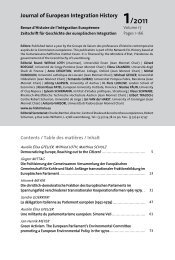journal of european integration history revue d'histoire de l ...
journal of european integration history revue d'histoire de l ...
journal of european integration history revue d'histoire de l ...
Create successful ePaper yourself
Turn your PDF publications into a flip-book with our unique Google optimized e-Paper software.
134<br />
comme une référence omniprésente dans les réflexions du temps sur l’union européenne, il aurait<br />
peut-être été judicieux d’inclure une étu<strong>de</strong> sur leur réaction à ce plan Briand <strong>de</strong>meuré sans postérité,<br />
mais qui marqua toute une génération <strong>de</strong> responsables européens.<br />
Laurence Ba<strong>de</strong>l<br />
Maître <strong>de</strong> conférences à l’Université <strong>de</strong> Paris-I Panthéon-Sorbonne<br />
Institut Pierre Renouvin<br />
Nathalie BERGER – La politique européenne d’asile et d’immigration. Enjeux et perspectives.<br />
Bruxelles. Bruylant. 2000, 269 p. – ISBN 2-8027-1299-3. –57,02€.<br />
The European asylum and immigration policy is striving for a common basis and succeeds<br />
little by little in establishing an i<strong>de</strong>ntity <strong>of</strong> its own. This is what Nathalie Berger intends to<br />
<strong>de</strong>monstrate in a work based on her doctoral thesis. In her capacity as a committed jurist,<br />
she studies the evolution <strong>of</strong> this policy by analysing closely the Treaties and Agreements<br />
having been signed from the Single Act to the Treaty <strong>of</strong> Amsterdam.<br />
After having <strong>de</strong>scribed the institutional framework both <strong>of</strong> the European immigration<br />
policy and the asylum policy, she studies each <strong>of</strong> these two policies in their evolution: an<br />
evolution, which has been chaotic in the early stages <strong>of</strong> the Schengen Agreement, the founding<br />
text, which aimed at a “close union <strong>of</strong> the peoples <strong>of</strong> the member States; then, with the<br />
signing <strong>of</strong> the Single Act and the Maastricht Treaty which merely favoured “intergovernmental<br />
cooperation”, the <strong>de</strong>velopment stagnated – to progress again with the Treaty <strong>of</strong><br />
Amsterdam which incorporated “the Schengen acquis” and which set itself the goal <strong>of</strong> creating<br />
an “area <strong>of</strong> freedom, security and justice”.<br />
Even though she states the common will for a supranational policy and thus for a common legislation,<br />
and <strong>de</strong>spite the efforts ma<strong>de</strong> since the economic crisis <strong>of</strong> the seventies, Nathalie Berger<br />
insists on the differences in the usual practices existing between the various European countries,<br />
which she attributes to the fact that the <strong>de</strong>finition <strong>of</strong> the word “foreign” which in international law is<br />
always linked to the notion <strong>of</strong> national sovereignty, varies from country to country.<br />
One part <strong>of</strong> her <strong>de</strong>monstration rests on the emphasis laid on the contradiction between the will<br />
shared by several member countries to favour immigration in or<strong>de</strong>r to answer the needs for<br />
labour force, and the absence <strong>of</strong> a common <strong>de</strong>finition <strong>of</strong> “third-country national”. Thus, on one<br />
hand she points out the ease with which European countries are achieving more and more positive<br />
results as regards the reinforcement <strong>of</strong> frontier controls and cooperation between police<br />
forces; on the other hand she shows up to what extent they are powerless in the face <strong>of</strong> countries<br />
that like the UK or Ireland continue to be opposed to all transfer <strong>of</strong> sovereignty, when the protection<br />
<strong>of</strong> these peoples is at stake. In the same way, in the face <strong>of</strong> the economic and social problems<br />
brought about by immigration and asylum, the author illuminates the Community’s difficulties<br />
regarding the conflicts <strong>of</strong> competence existing between the European Commission, the Council<br />
<strong>of</strong> Europe and finally the Court <strong>of</strong> Justice, which make it <strong>de</strong> facto possible for the member States<br />
to keep to their national legislation. The analysis <strong>of</strong> the asylum policy <strong>de</strong>fined by the Dublin convention<br />
comes to the same conclusion. Its application too comes up against a variety <strong>of</strong> national<br />
procedures, even if at the level <strong>of</strong> principles, it constitutes a positive step in comparison with the<br />
Geneva Convention. The work gives not only an account <strong>of</strong> the situation, it also actively attempts<br />
to outline institutional solutions that materialise the Community’s political will to combine ethics<br />
and cautiousness.<br />
For the author, who <strong>de</strong>scribes very exhaustively the different national exceptions, the asylum<br />
and immigration policy in its present state <strong>of</strong> realisation amounts to nothing more than an intensi-

















